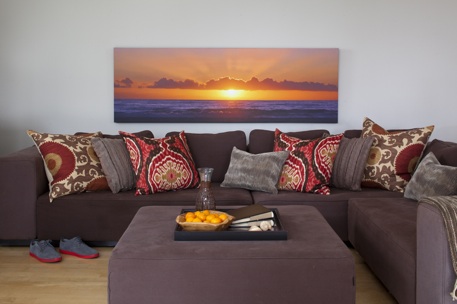You've been framed
« Browse all tipsDon’t be afraid to go BIG!
CanvasPop shares their top 5 tips on creating impact and focus through large-format art
Small art, no matter how compelling or creative, can easily be swallowed in a room. As a photographer, you know that BIG images create BIG impact, so here are some tips for capturing shots that people won’t be able to take their eyes off of.
Go Macro
Get up close and personal with your subject! Macro photography isn’t limited to insects and flowers—try exploiting everyday objects for their patterns, details, and textures to create mystery and perplex the viewer. You’ll naturally create interest and focus by blowing up a small detail into something that’s larger-than-life.
Create Contrast
Great contrast in itself is a secret to creating awe-inspiring photography, but high-contrast photos can especially command attention and define space when printed large-format. There’s an infinite number of ways to explore contrast—shoot or switch to black and white, seek high-contrast light, or practice the rule of thirds.
There’s figurative contrast, too—search out or compose photos that showcase competing elements. Creating juxtaposition and evoking contrasting emotions will pique interest by pulling the viewer into the story.
And don’t forget about color! Refresh yourself on the color wheel and complementary colors—red and green, yellow and purple, blue and orange—they’re a foundational element of contrast.
See the Space
It’s a luxury to stake out the location where your photos will be hung, but if you get the opportunity, jump on it. Not everyone has spatial intelligence, but as a photographer you’re trained in it—pass that knowledge onto your clients and they’ll be even happier with your work.
If you can lay eyes on the intended wall space, you can further understand your client’s needs and vision, then help them maximize the impact of their new art by recommending the appropriate size. You’ll also be able to address any complementary (or competing) architectural details and advise accordingly.
Get perspective
Get down low. Climb up high. Walk right. Jump left. The most effective way to change the perspective in photography is to capture the relative size, scale, space and position of the objects in your photo through different vantage points. Changing perspective lets you manipulate the relationships and stories of your subjects.
Lenses can also play a key role in perspective adjustment. A wide-angle lens will shift the linear perspective and over-emphasize it, while a long telephoto lens can shorten the perceived distance. Different lenses allow you to frame the shot from a viewpoint that gives you a new perspective, but you’ll still need to move around!
Grids and Groups
Remember that you can create high-impact, large-format art installations with groupings of smaller photos. Take the opportunity to tell the bigger story with multiple images hung on the same wall.
Be sure to measure properly and use a grid system when placing multiple images on the same wall, or otherwise the eye may be drawn to the wrong focal point—inconsistent spacing! That doesn’t mean you can’t have fun and stagger the images—just be sure to plan it out and balance the photos subjects within the collage.
New to MOO?
MOO makes life a little less virtual. We help our customers print things like business cards, postcards, flyers and stickers, making it easy for them to share information about themselves or their business in the real world.
Print is simple and wonderful. We love it.
View Our Products




